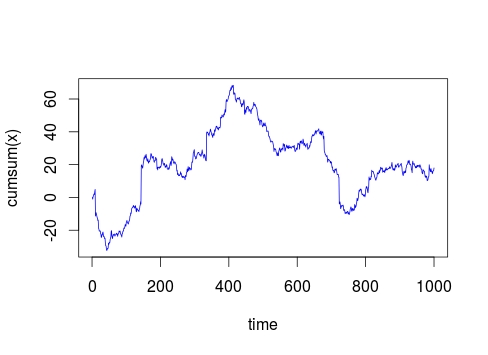|
Randomness Test
A randomness test (or test for randomness), in data evaluation, is a test used to analyze the distribution of a set of data to see if it can be described as random (patternless). In stochastic modeling, as in some computer simulations, the hoped-for randomness of potential input data can be verified, by a formal test for randomness, to show that the data are valid for use in simulation runs. In some cases, data reveals an obvious non-random pattern, as with so-called "runs in the data" (such as expecting random 0–9 but finding "4 3 2 1 0 4 3 2 1..." and rarely going above 4). If a selected set of data fails the tests, then parameters can be changed or other randomized data can be used which does pass the tests for randomness. Background The issue of randomness is an important philosophical and theoretical question. Tests for randomness can be used to determine whether a data set has a recognisable pattern, which would indicate that the process that generated it is significa ... [...More Info...] [...Related Items...] OR: [Wikipedia] [Google] [Baidu] |
Random
In common usage, randomness is the apparent or actual lack of pattern or predictability in events. A random sequence of events, symbols or steps often has no order and does not follow an intelligible pattern or combination. Individual random events are, by definition, unpredictable, but if the probability distribution is known, the frequency of different outcomes over repeated events (or "trials") is predictable.Strictly speaking, the frequency of an outcome will converge almost surely to a predictable value as the number of trials becomes arbitrarily large. Non-convergence or convergence to a different value is possible, but has probability zero. For example, when throwing two dice, the outcome of any particular roll is unpredictable, but a sum of 7 will tend to occur twice as often as 4. In this view, randomness is not haphazardness; it is a measure of uncertainty of an outcome. Randomness applies to concepts of chance, probability, and information entropy. The field ... [...More Info...] [...Related Items...] OR: [Wikipedia] [Google] [Baidu] |
Complexity
Complexity characterises the behaviour of a system or model whose components interact in multiple ways and follow local rules, leading to nonlinearity, randomness, collective dynamics, hierarchy, and emergence. The term is generally used to characterize something with many parts where those parts interact with each other in multiple ways, culminating in a higher order of emergence greater than the sum of its parts. The study of these complex linkages at various scales is the main goal of complex systems theory. The intuitive criterion of complexity can be formulated as follows: a system would be more complex if more parts could be distinguished, and if more connections between them existed. Science takes a number of approaches to characterizing complexity; Zayed ''et al.'' reflect many of these. Neil Johnson states that "even among scientists, there is no unique definition of complexity – and the scientific notion has traditionally been conveyed using particular examples ... [...More Info...] [...Related Items...] OR: [Wikipedia] [Google] [Baidu] |
Seven States Of Randomness
The seven states of randomness in probability theory, fractals and risk analysis are extensions of the concept of randomness as modeled by the normal distribution. These seven states were first introduced by Benoît Mandelbrot in his 1997 book ''Fractals and Scaling in Finance'', which applied fractal analysis to the study of risk and randomness.Benoît Mandelbrot (1997) ''Fractals and scaling in finance'' pages 136–142 https://books.google.com/books/about/Fractals_and_Scaling_in_Finance.html?id=6KGSYANlwHAC&redir_esc=y This classification builds upon the three main states of randomness: mild, slow, and wild. The importance of seven states of randomness classification for mathematical finance is that methods such as Markowitz mean variance portfolio and Black–Scholes model may be invalidated as the tails of the distribution of returns are fattened: the former relies on finite standard deviation ( volatility) and stability of correlation, while the latter is construc ... [...More Info...] [...Related Items...] OR: [Wikipedia] [Google] [Baidu] |
Algorithmically Random Sequence
Intuitively, an algorithmically random sequence (or random sequence) is a Sequence#Infinite sequences in theoretical computer science, sequence of binary digits that appears random to any algorithm running on a (prefix-free or not) universal Turing machine. The notion can be applied analogously to sequences on any finite alphabet (e.g. decimal digits). Random sequences are key objects of study in algorithmic information theory. As different types of algorithms are sometimes considered, ranging from algorithms with specific bounds on their running time to algorithms which may ask questions of an oracle machine, there are different notions of randomness. The most common of these is known as Martin-Löf randomness (K-randomness or 1-randomness), but stronger and weaker forms of randomness also exist. When the term "algorithmically random" is used to refer to a particular single (finite or infinite) sequence without clarification, it is usually taken to mean "incompressible" or, in t ... [...More Info...] [...Related Items...] OR: [Wikipedia] [Google] [Baidu] |
Statistical Randomness
A numeric sequence is said to be statistically random when it contains no recognizable patterns or regularities; sequences such as the results of an ideal dice roll or the digits of π exhibit statistical randomness. Statistical randomness does not necessarily imply "true" randomness, i.e., objective unpredictability. Pseudorandomness is sufficient for many uses, such as statistics, hence the name ''statistical'' randomness. ''Global randomness'' and ''local randomness'' are different. Most philosophical conceptions of randomness are global—because they are based on the idea that "in the long run" a sequence looks truly random, even if certain sub-sequences would ''not'' look random. In a "truly" random sequence of numbers of sufficient length, for example, it is probable there would be long sequences of nothing but repeating numbers, though on the whole the sequence might be random. ''Local'' randomness refers to the idea that there can be minimum sequence lengths in whi ... [...More Info...] [...Related Items...] OR: [Wikipedia] [Google] [Baidu] |
Randomness
In common usage, randomness is the apparent or actual lack of pattern or predictability in events. A random sequence of events, symbols or steps often has no order and does not follow an intelligible pattern or combination. Individual random events are, by definition, unpredictable, but if the probability distribution is known, the frequency of different outcomes over repeated events (or "trials") is predictable.Strictly speaking, the frequency of an outcome will converge almost surely to a predictable value as the number of trials becomes arbitrarily large. Non-convergence or convergence to a different value is possible, but has probability zero. For example, when throwing two dice, the outcome of any particular roll is unpredictable, but a sum of 7 will tend to occur twice as often as 4. In this view, randomness is not haphazardness; it is a measure of uncertainty of an outcome. Randomness applies to concepts of chance, probability, and information entropy. The fields o ... [...More Info...] [...Related Items...] OR: [Wikipedia] [Google] [Baidu] |
Basis Function
In mathematics, a basis function is an element of a particular basis for a function space. Every function in the function space can be represented as a linear combination of basis functions, just as every vector in a vector space can be represented as a linear combination of basis vectors. In numerical analysis and approximation theory, basis functions are also called blending functions, because of their use in interpolation: In this application, a mixture of the basis functions provides an interpolating function (with the "blend" depending on the evaluation of the basis functions at the data points). Examples Monomial basis for ''Cω'' The monomial basis for the vector space of analytic functions is given by \. This basis is used in Taylor series, amongst others. Monomial basis for polynomials The monomial basis also forms a basis for the vector space of polynomials. After all, every polynomial can be written as a_0 + a_1x^1 + a_2x^2 + \cdots + a_n x^n for some n \in \ ... [...More Info...] [...Related Items...] OR: [Wikipedia] [Google] [Baidu] |
String (computer Science)
In computer programming, a string is traditionally a sequence of characters, either as a literal constant or as some kind of variable. The latter may allow its elements to be mutated and the length changed, or it may be fixed (after creation). A string is generally considered as a data type and is often implemented as an array data structure of bytes (or words) that stores a sequence of elements, typically characters, using some character encoding. ''String'' may also denote more general arrays or other sequence (or list) data types and structures. Depending on the programming language and precise data type used, a variable declared to be a string may either cause storage in memory to be statically allocated for a predetermined maximum length or employ dynamic allocation to allow it to hold a variable number of elements. When a string appears literally in source code, it is known as a string literal or an anonymous string. In formal languages, which are used in ma ... [...More Info...] [...Related Items...] OR: [Wikipedia] [Google] [Baidu] |
Martin-Löf Random
Intuitively, an algorithmically random sequence (or random sequence) is a sequence of binary digits that appears random to any algorithm running on a (prefix-free or not) universal Turing machine. The notion can be applied analogously to sequences on any finite alphabet (e.g. decimal digits). Random sequences are key objects of study in algorithmic information theory. As different types of algorithms are sometimes considered, ranging from algorithms with specific bounds on their running time to algorithms which may ask questions of an oracle machine, there are different notions of randomness. The most common of these is known as Martin-Löf randomness (K-randomness or 1-randomness), but stronger and weaker forms of randomness also exist. When the term "algorithmically random" is used to refer to a particular single (finite or infinite) sequence without clarification, it is usually taken to mean "incompressible" or, in the case the sequence is infinite and prefix algorithmically r ... [...More Info...] [...Related Items...] OR: [Wikipedia] [Google] [Baidu] |
Kolmogorov Complexity
In algorithmic information theory (a subfield of computer science and mathematics), the Kolmogorov complexity of an object, such as a piece of text, is the length of a shortest computer program (in a predetermined programming language) that produces the object as output. It is a measure of the computational resources needed to specify the object, and is also known as algorithmic complexity, Solomonoff–Kolmogorov–Chaitin complexity, program-size complexity, descriptive complexity, or algorithmic entropy. It is named after Andrey Kolmogorov, who first published on the subject in 1963 and is a generalization of classical information theory. The notion of Kolmogorov complexity can be used to state and prove impossibility results akin to Cantor's diagonal argument, Gödel's incompleteness theorem, and Turing's halting problem. In particular, no program ''P'' computing a lower bound for each text's Kolmogorov complexity can return a value essentially larger than ''P'''s own len ... [...More Info...] [...Related Items...] OR: [Wikipedia] [Google] [Baidu] |
George Marsaglia
George Marsaglia (March 12, 1924 – February 15, 2011) was an American mathematician and computer scientist. He is best known for creating the diehard tests, a suite of software for measuring statistical randomness. Research on random numbers George Marsaglia established the lattice structure of linear congruential generators in the paper "Random numbers fall mainly in the planes", later termed the Marsaglia's theorem. This phenomenon means that ''n''-tuples with coordinates obtained from consecutive use of the generator will lie on a small number of equally spaced hyperplanes in ''n''-dimensional space. He also developed the diehard tests, a series of tests to determine whether or not a sequence of numbers have the statistical properties that could be expected from a random sequence. In 1995 he published a CD-ROM of random numbers, which included the diehard tests. His diehard paper came with the quotation "Nothing is random, only uncertain" attributed to ''Gail Gasra ... [...More Info...] [...Related Items...] OR: [Wikipedia] [Google] [Baidu] |




